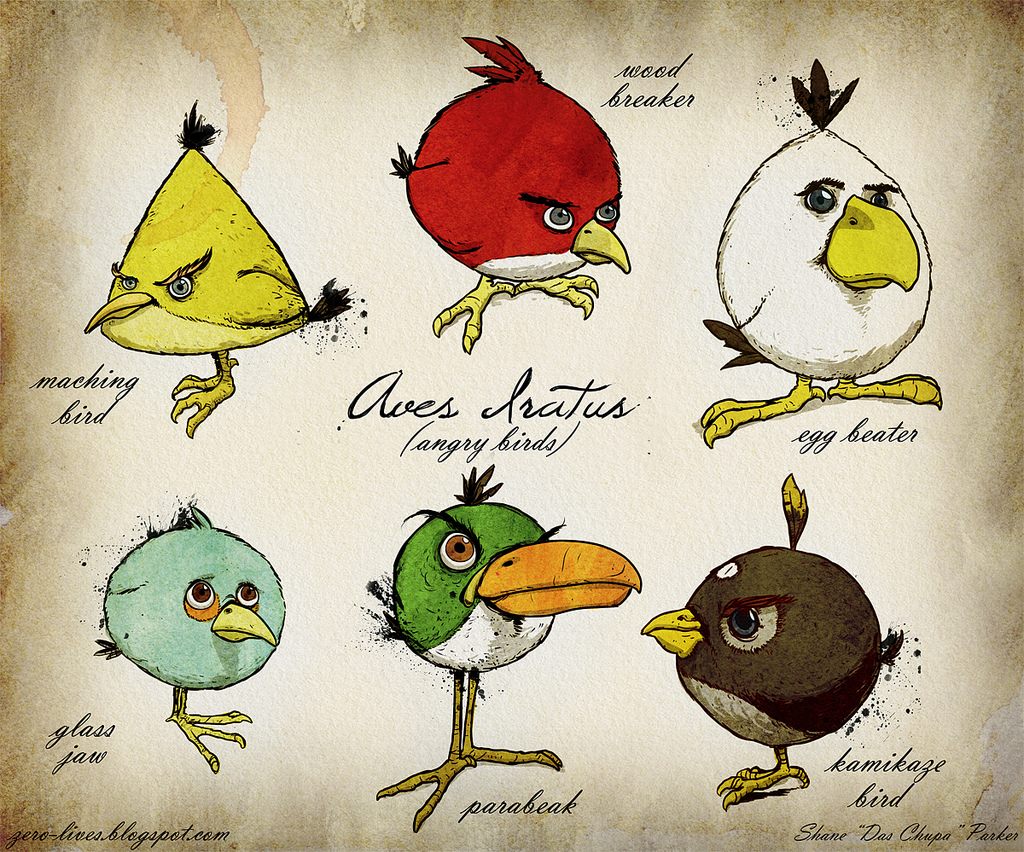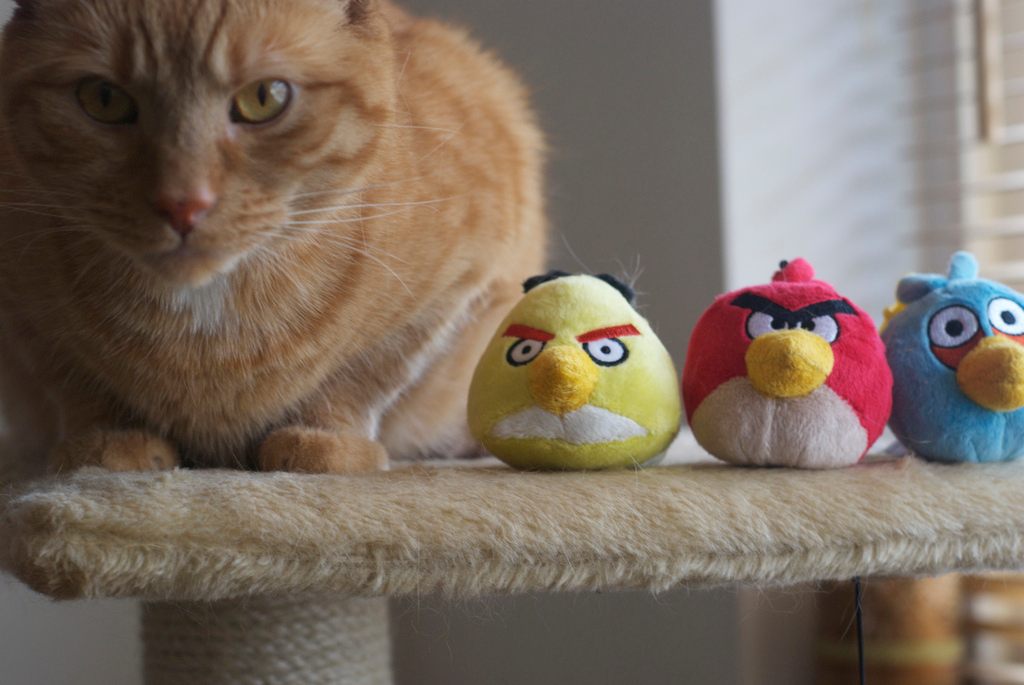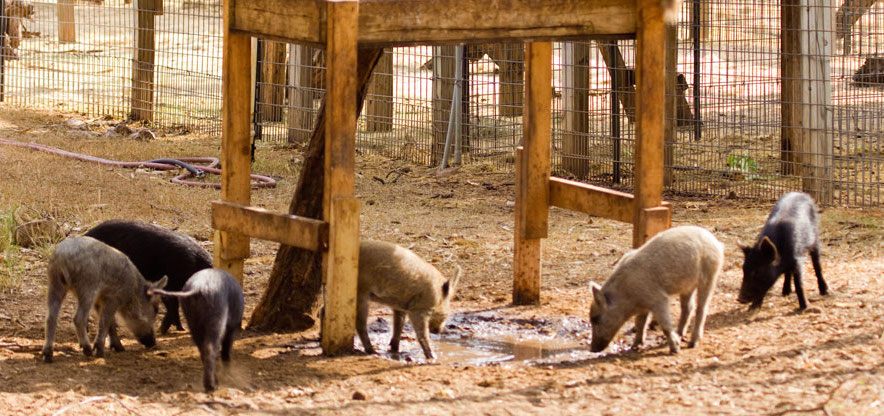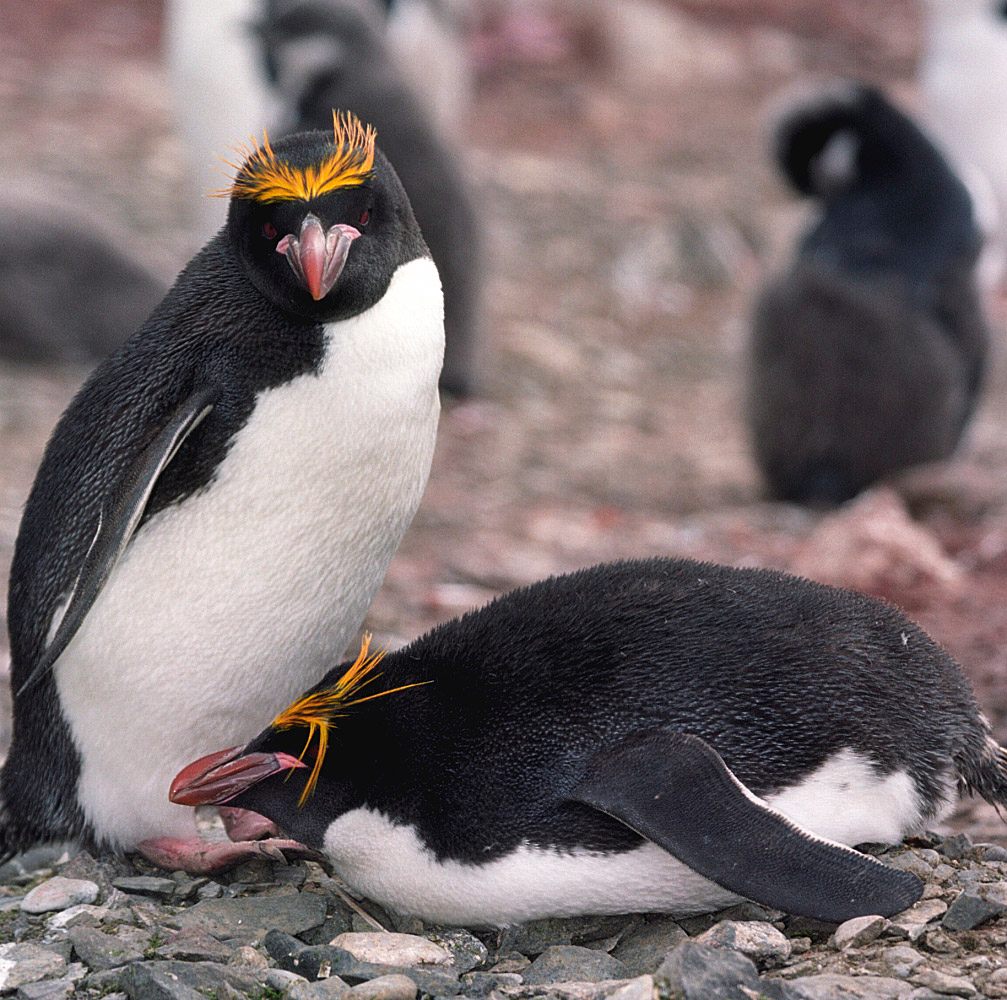We Asked An Ornithologist To Factcheck Angry Birds–And the Results Might Surprise You

An artist’s conception of scientific illustrations of Angry Birds. (Image courtesy of Shane Parker)
It’s hard to say why so many of the world’s most popular mobile games—Angry Birds, Flappy Bird, Crossy Road—feature birds. Maybe avian creatures are just easy to animate. Maybe we can’t pass up the opportunity to tweak dinosaurs about how far they’ve fallen. Or maybe something about birds’ tiny brains feels familiar to someone who’s been playing the same phone game for ten hours straight. It doesn’t matter.
The important question is this: are these games ornithologically rigorous?
Given the amount of time I spend on mobile games, I expect a high level of edification. For instance, I assume that I am now an expert at both minesweeping and candy crushing, and my friends could call on me if they encountered a live minefield or their path was blocked by uncrushed candy. Are the nation’s bird games upholding this standard of accuracy? Or are we being sold a bill of goods about a chicken’s methodology for crossing the road, or the ancient enmity between birds and pigs?
To answer this question, I spoke to Dr. Miyoko Chu, senior director of communications for the Cornell Lab of Ornithology and a Ph.D. ornithologist. At my insistence, Dr. Chu played several bird-related mobile games (Angry Birds, Crossy Road, Tiny Wings, and Flappy Bird) and she reports that in terms of ornithological fidelity they’re… actually not that bad. While the apps may not double as a crash course in avian behaviorism, the birds inside your phone have a surprising number of things in common with the ones outside your window.

This camaraderie with cats is far-fetched, though. (Photo: Melinda Seckington/flickr)
Angry Birds
You probably know about the Angry Birds franchise; it’s the most downloaded freemium game series (i.e. a free download that makes money by charging for in-game bonuses and upgrades) of all time. There are even Angry Birds theme parks, and an animated movie coming out next year. But for the uninitiated: the premise of Angry Birds is that a bunch of birds are trying to get their stolen eggs back from evil pigs. The pigs like to protect themselves inside makeshift buildings, so the birds – with the help of the player – must use a slingshot to launch themselves at these structures, destroying them. (Most of the birds then explode in a puff of feathers.)
As it turns out, the central premise—beef between the birds and pigs—holds water. Sometimes, birds and pigs really are enemies. In Hawaii, feral pigs, the formerly-domesticated farm animals that have gone back to the land, are a serious threat to avian habitats. According to the Kaua’i Forest Bird Recovery Project, pigs are threats to birds in three different ways: they threaten forest health by trampling or uprooting tree seedlings and other important plants; they increase the range of invasive plant species by eating the fruits and defecating the seeds elsewhere in the forest; and they help spread deadly non-native disease to local birds, by creating wallows full of standing water that become breeding grounds for mosquitos. All of this directly or indirectly affects birds’ health and well-being. In Texas, the pig-bird conflict is even more reminiscent of Angry Birds: feral hogs steal and eat the eggs of ground-nesting birds like the northern bobwhite and the wild turkey.

Texan feral pigs in one of their makeshift structures, before it was destroyed by birds. (Okay, TECHNICALLY they have wandered into a primate sanctuary, and those structures were built by humans for the use of monkeys. But I couldn’t resist.) (Photo: Becker1999/flickr)
Dr. Chu said she wasn’t aware of any birds that respond to these porcine incursions by catapulting themselves around. But she was more struck by another aspect of the game that seemed unrealistic: the birds’ apparent willingness to make kamikaze strikes. At the beginning of each level, the birds are “eagerly lining up to be the next projectile to hit a rock and be reduced to a pile of feathers,” she noted, but it’s unlikely real birds would be that irrational. “Birds are pretty savvy,” Dr. Chu told me. “There are some things that they might do that seem suicidal to us – for example blackpoll warblers will fly over the Atlantic Ocean all the way to South America in the fall.” But even such a dangerous endeavor is done in the name of survival, in this case, escaping the killing cold.
Even more unlikely is the situation where birds sacrifice themselves after watching other birds do the same thing. “They’re observant,” says Dr. Chu. “If they notice another bird being killed, they’ll be more cautious around that situation.” In areas where birds are hunted, for example, they’re wary of humans, whereas birds that lack natural predators (like the ones in the Galapagos) have no fear of strangers. If a bird saw another bird plummet headfirst into some kind of hastily-made pig shanty and explode, it would be very unlikely to do the same. “From a bird biologist perspective,” Dr. Chu says, “seeing them line up to be the next projectile is a bit of a head-scratcher.”
Then again, Angry Birds, once they disintegrate into feathers and dust, do regenerate in time for the next level. Dr. Chu confirmed that most birds do not have this power.

The Crossy Road chicken. (Photo: downloadsource.fr/flickr)
Crossy Road
Crossy Road is a Frogger-esque game in which you navigate your character – by default, a chicken – across a series of roads, rivers, and railroad tracks. Dangers include cars, trucks, trains, and moving logs where one false step could dump you in the river; to succeed, you must avoid all these, while simultaneously picking up gold coins that are often smack in the middle of the road.
One of the questions raised by this game is a classic: why did the chicken cross the road? “I assure you, ornithologists don’t know the answer to that question, any more than they know the answer to why humans spend hours getting chickens to cross the road on our phones,” Dr. Chu told me. “But roadkill is definitely a problem; there are some numbers suggesting that more than 200 million birds per year are killed by collisions with vehicles in the United States alone.”
Nevertheless, some birds have become adept at dodging cars. One study found that in road areas with higher speed limits, birds will take off faster when they see a car coming, speeding up in a way that seems to anticipate the greater vehicle speed. “It’s not that they necessarily gauge the speed of each car,” Dr. Chu said, but they’re able to learn that “in certain areas they need to react a little faster because cars are moving faster.”
Other birds have gone even further in finessing their relationship with road vehicles by learning how to use moving cars as nutcrackers. Both crows and gulls have figured out that they can drop objects, like nuts or clams, onto the ground to break them open. But some crows have realized that it’s even more effective to drop the nuts into a busy road, and let the cars run over them to break the shell. “That in itself is kind of interesting and clever on the part of the bird,” says Dr. Chu, “but then, just like in Crossy Road, the danger comes when you swoop down and try to get the nut in between all these cars going back and forth.”
A few terrifyingly smart crows, though, have figured out a solution: they still drop the nuts into the road, but they aim specifically for pedestrian crosswalks. “They wait until the signal changes and the people start walking across, and they just join the people, and walk among the people across the road and get their nut, and then they fly off before the traffic starts up again.” That chicken picking up road coins suddenly looks awfully realistic.
You don’t have to play as a chicken in Crossy Road—you can unlock other avatars, including other birds (duck, goose, and kiwi) but also a pug dog, a capybara, a bunny, a basketball player, Frankenstein’s monster, and more. But there’s one bird who’s a consistent presence: the eagle, which swoops down and carries off your character if you hesitate too long.
As it turns out, this is pretty realistic, too. “Raptors are opportunists,” Dr. Chu told me. “Often, you will see red-tailed hawks, for example, perched on the sides of highways, and they’ll be up on a wire looking down at the road.” They’re not thinking about cracking nuts—they’re looking for prey. “Areas on the sides of the road are often areas where they can see the prey from above, because it’s open by the road, so those are favorite hunting spots for them.” That seems to be pretty much what the Crossy Road eagle is up to: waiting by the road to snap up prey that stands still too long.
If a chicken were in fact crossing the road, said Dr. Chu, it might make a tempting morsel for an eagle. Some of the other playable critters, like the bunnies, would probably be in even more danger, although she admitted that “it wouldn’t be realistic for an eagle to pick up a basketball player.” (It should be noted that Dr. Chu got way further in this game than me. I hadn’t even realized there was a basketball player until she mentioned it.) But those animals are on the small side as meals. “There are some eagles in other parts of the world, the harpy eagle and the Philippine eagle, that will eat prey as large as a monkey,” she says. Dang, let’s have a game about them.

The Philippine eagle: approximately one million times more badass than a chicken. (Photo: Ismail Cacharro/WikiCommons)
Tiny Wings
The concept of Tiny Wings is simple: You are a bird with tiny wings. They are, in fact, too tiny to lift you off the ground. So in order to achieve the dream of flight, you must gather enough momentum to launch yourself into the sky—either by gently sliding down the slope of a rolling hill, or even better, by cannonballing out of the sky and then sliding down the slope of a rolling hill really fast.
There are certainly birds (kiwis, ostriches, emus, flightless cormorants, just to name a few) whose wings are too small to lift them off the ground. And there are birds who slide on their stomachs rather than flying—specifically, penguins, whose belly-slides on the ice are much more graceful than their waddling upright walks. But Dr. Chu couldn’t picture a bird in a temperate climate, like the one suggested by the Tiny Wings landscape, using such a method of locomotion.
“Sliding doesn’t get you very far when it’s bare ground. The conditions with the penguins are frictionless snow and ice,” she said. “I can’t really imagine it because there’s just so much friction.” Wet or muddy slopes might be slippery enough, but birds probably wouldn’t want to slide down them as a matter of course. “The cleanliness of feathers is really important to birds because it provides their insulation,” said Dr. Chu, “so I’m not sure how willing a bird would be to slide on mud.” Presumably Clean Wings was considered as a game concept, but was narrowly edged out.

“You heard the lady, Greg. This only works on ice.” (Photo: Jerzy Srtzelecki/WikiCommons)
Flappy Bird
I didn’t make Dr. Chu play the original Flappy Bird, because the Lab of Ornithology would have needed to take out a special grant. The infamously difficult-to-play game’s developer removed it from the App Store in 2014, apparently because he felt guilty about it being so addictive. In the wake of the removal, smartphones with Flappy Bird installed were getting bids of nearly $100,000 on eBay. (The sales didn’t go through; it’s against eBay’s policies to sell smartphones that haven’t been restored to factory settings.) There are tons and tons of free clones available, though, which faithfully reproduce the original’s objective (fly your clumsy bird through a series of Mario-looking pipes without hitting any of them) and gameplay experience (total rage and frustration).
Dr. Chu thought that the setting of Flappy Bird—a cityscape in the background, and a constant line of obstructions – could give players a pretty good feel for birds’ experience trying to navigate human architecture, which probably feels like a series of deadly hurdles. “Maybe this game is a metaphor for a forest of buildings or a forest of human-made obstacles,” she said. “If we think that collisions with vehicles are worrisome, the number is even larger for collisions with buildings. Some estimates say 599 million collisions with buildings each year kill birds in the United States alone.”
If you’re irritated and confused playing Flappy Bird, imagine how it feels to be a bird trying to migrate when there’s a city in the way. Songbirds often migrate at night, in the dark, Dr. Chu told me. The lights in buildings confuse them, acting as beacons that entice them to fly into windows. “If a bird has good visibility, and it’s a normal day, they’re going to be able to avoid those buildings, unlike Flappy Bird,” said Dr. Chu. “But when they’re confused and it’s dark and the lights are an unnatural source that draws them in, then the next day you can find birds at the base of the building that have died, like in the game.”
In other words, the problem isn’t the recalcitrant bird. It’s whoever left all those pipes there.

A not atypical score in Flappy Bird. (Photo: Eurritimia/flickr)
Part of the infernal appeal of Flappy Bird is that the bird itself is difficult to control, but Dr. Chu didn’t really want to comment on whether that was accurate. “Ornithologists don’t try to control birds,” she admonished me, “because they’re pretty much free spirits.” The real goal of a bird scientist—and of any bird lover—is not to navigate birds away from danger, but to encourage humans to be less dangerous in the first place. “We wish we could influence the behavior of the people, and inspire people to recognize that birds are beautiful and unique and important enough that we have to change our human behaviors related to habitat destruction,” Dr. Chu said. “The birds themselves, they don’t frustrate us.”
The bird games, on the other hand, can be extremely frustrating at times. But there are worse ways to cultivate empathy for our feathered friends. Just remember, when you look up from the screen in about five hours, to keep caring about what you can do to help protect birds and their habitats —from pigs, but also from people like you.









Follow us on Twitter to get the latest on the world's hidden wonders.
Like us on Facebook to get the latest on the world's hidden wonders.
Follow us on Twitter Like us on Facebook